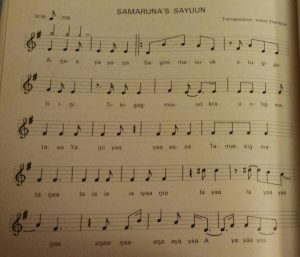In this lesson, I intend to focus on the music and dance of the Inupiaq people and incorporate elements of rhythm, movement, and performance.
Age Level: appropriate for 6th grade music performance class, or 6th through 8th grade music appreciation class
Materials needed: 1 large frame drum, sheet music for traditional Inupiaq song
Duration: 1-5 class periods
Goal: Internalizing rhythm
Objectives:
1. To teach students fundamental musical concepts/skills of inner pulse and eurythmics through guided movement, kinesthetic learning, and performance
2. To teach students how to actively listen to a leader, to each other, and to the pulse of the music
3. To teach students the movements to a traditional Inupiaq dance
4. To teach students how to sing and play a traditional Inupiaq dance
5. To highlight the storytelling aspects of music
6. To show how music reveals the stories and cultural values of a people
Outcomes:
1. Students should be able to move in time with a steady pulse
2. Students should be able to demonstrate a steady pulse while playing simple rhythms on a drum
3. Students should be able to move in time with the rhythm of a traditional Inupiaq song
4. Students should be able to demonstrate the correct movements to a traditional Inupiaq dance
5. Students should be able to sing and play (on a drum or another instrument) a traditional Inupiaq song
Description:
In this lesson, students will participate in a series of 6 sequential activities, which will be either game-based or performance-based. The lesson will meld learning basic music skills, such as inner pulse and eurythmics, with learning an Inupiaq traditional song and dance with the goal of performing it.
For the game elements of this lesson, one person will play a rhythm on a drum while the rest of the class listens and moves in time with the drumbeat. For the performative elements of this lesson, students will learn the notes, rhythms, movements, and cultural context of a traditional Inupiaq song and dance.
The 6 sequential activities are as follows:
1. The class will play a movement game with a drum. The teacher will be the leader for this round of the game. The teacher plays a rhythm on the drum, and the students must take one step per beat they hear on the drum. The leader can change the rhythm, increase the tempo, or decrease the tempo at any time. The students must stay with the drumbeat at all times.
2. The class will play a different version of the movement game with the drum. This time, each student will take a turn being the leader and playing the drum. On his or her turn, each student plays a rhythm on the drum, and the rest of the class must take one step per beat they hear on the drum. The leader can change the rhythm, increase the tempo, or decrease the tempo at any time. The rest of the class must stay with the drumbeat at all times.
3. The class will play a third version of the movement game with the drum, this time using the percussion rhythm of an Inupiaq song as the basis of the activity. The teacher will be the leader again for this round of the game. The teacher plays the rhythm of the percussion part on the drum, and the students must take one step per beat that they hear. The students’ goal is to physically internalize the rhythm of the Inupiaq song.
4. The class will play a fourth version of the movement game with the drum. The teacher will be the leader. In this round, the teacher will play the melodic rhythm of the Inupiaq song on the drum. The students must take one step per beat that they hear. This will help the students to physically internalize the rhythm of the melody part.
5. The students will learn the body movements of the Inupiaq dance, which goes with the Inupiaq song to which they are being introduced.
6. The students will learn to sing, play, and dance the Inupiaq song introduced earlier in the lesson. They will apply what they learned about eurythmics and inner pulse in the earlier movement/rhythm games to the song.

Kate – Sounds like fun for the students and a great way to teach the content.
Just tossing out a few ideas here:
If you could find video of real dancers you might let them see the video after they had tried it themselves. Or play the video of dancers without sound and see if they could clap the rhythm before turning the sound back on.
Also wondering if you could video tape them to show them how they looked in their steps.
I also thought of making it a bit of a game so some had to sit down when they got steps wrong, but I hate singling out failure. Would there be some positive way to acknowledge students who are able to accurately do the steps?
I love it! Especially how it gets the kids moving. My mom took an Alaska Native Music Appreciation class as part of her continuing education as a music teacher and I remember her talking about how most music wasn’t available on CD or notated because of a kind of cultural copyright–like you can listen but you can’t have a copy for yourself. Is that something you’ve run into? I’m not sure if this was applicable to only one region, but if it does correspond are you going to talk to the kids about it?